Stephanie A. Mann's Blog, page 237
May 17, 2014
Who Is Our Lady of Laus? Tune in Tomorrow to Find Out More
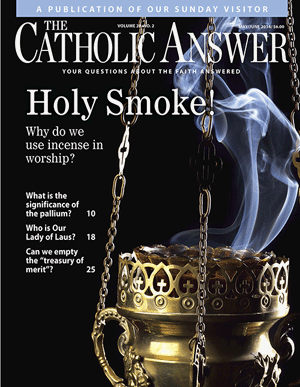
I'll be on the Son Rise Morning Show tomorrow after the 7:45 a.m. Eastern/6:45 a.m. Central transition--the last segment of the EWTN broadcast that morning--to talk about Our Lady of Laus (pronounced Low). I had never heard about Our Lady of Laus before Dr. Matthew Bunson asked me to write an article for OSV's The Catholic Answer Magazine! More about Our Lady of Laus and the special distinctions of these approved Marian apparitions in the south of France at the foot of the Alps in the vale of Laus.
Published on May 17, 2014 22:30
May 16, 2014
Books, Books, Books! Three in Queue
I have three great books lined up for Summer reading. I've started the first one, Romantic Catholics: France's Postrevolutionary Generation in Search of a Modern Faith by Carol E. Harrison from Cornell University Press:
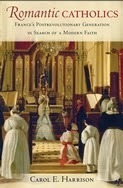
In this well-written and imaginatively structured book, Carol E. Harrison brings to life a cohort of nineteenth-century French men and women who argued that a reformed Catholicism could reconcile the divisions in French culture and society that were the legacy of revolution and empire. They include, most prominently, Charles de Montalembert, Pauline Craven, Amélie and Frédéric Ozanam, Léopoldine Hugo, Maurice de Guérin, and Victorine Monniot. The men and women whose stories appear in Romantic Catholics were bound together by filial love, friendship, and in some cases marriage. Harrison draws on their diaries, letters, and published works to construct a portrait of a generation linked by a determination to live their faith in a modern world.
Rejecting both the atomizing force of revolutionary liberalism and the increasing intransigence of the church hierarchy, the romantic Catholics advocated a middle way, in which a revitalized Catholic faith and liberty formed the basis for modern society. Harrison traces the history of nineteenth-century France and, in parallel, the life course of these individuals as they grow up, learn independence, and take on the responsibilities and disappointments of adulthood. Although the shared goals of the romantic Catholics were never realized in French politics and culture, Harrison's work offers a significant corrective to the traditional understanding of the opposition between religion and the secular republican tradition in France.
As I read the introduction I thought how nineteenth century Catholics in both England and France had to rebuild their churches--the English after centuries of penal laws and martyrdom; the French after the Revolution, the Terror, and the revolutionary campaign of De-Christianization that led to destruction of churches, suppression of monasteries, and the martyrdom of priests and nuns. The difference for the French, as Harrison is explaining to me, is that as the Catholic laity worked to influence their society--re-evangelize it!--they also had to consider the Church's relationship with the monarchy and whether it was good for the Church or not. Harrison notes in the introduction that nineteenth century Catholics in France were for a time at least solidly ultramontane, ascribing the weakness of the Church in France during the Ancien Regime partially to its Cisalpine stance of loyalty to the Bourbons instead of the Papacy. More on Romantic Catholics after I've read it!
Then I have The Oxford Movement: Europe and the Wider World 1830-1930, edited by Stewart J. Brown and Peter B. Nockles from Cambridge:
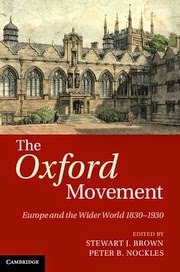
The Oxford Movement transformed the nineteenth-century Church of England with a renewed conception of itself as a spiritual body. Initiated in the early 1830s by members of the University of Oxford, it was a response to threats to the established church posed by British Dissenters, Irish Catholics, Whig and Radical politicians, and the predominant evangelical ethos – what Newman called 'the religion of the day'. The Tractarians believed they were not simply addressing difficulties within their national Church, but recovering universal principles of the Christian faith. To what extent were their beliefs and ideals communicated globally? Was missionary activity the product of the movement's distinctive principles? Did their understanding of the Church promote, or inhibit, closer relations among the churches of the global Anglican Communion? This volume addresses these questions and more with a series of case studies involving Europe and the English-speaking world during the first century of the Movement.
My husband gave me both of these books for Mother's Day!
And finally, thanks to the Queen Anne Boleyn blog and Beth von Staats who introduced us in a way, I have received a review copy of God's Traitors: Terror and Faith in Elizabethan England, from the author herself, Jessie Childs!
The Catholics of Elizabethan England did not witness a golden age. Their Mass was banned, their priests were outlawed, their faith was criminalised. In an age of assassination and Armada, those Catholics who clung to their faith were increasingly seen as the enemy within. In this superb history, award-winning author Jessie Childs explores the Catholic predicament in Elizabethan England through the eyes of one remarkable family: the Vauxes of Harrowden Hall.
God’s Traitors is a tale of dawn raids and daring escapes, stately homes and torture chambers, ciphers, secrets and lies. From clandestine chapels and side-street inns to exile communities and the corridors of power, it exposes the tensions and insecurities masked by the cult of Gloriana. Above all, it is a timely story of courage and frailty, repression and reaction and the terrible consequences when religion and politics collide.
I may have to bump God's Traitors up in the queue after Romantic Catholics!
What are you reading, readers? Or planning to read?

In this well-written and imaginatively structured book, Carol E. Harrison brings to life a cohort of nineteenth-century French men and women who argued that a reformed Catholicism could reconcile the divisions in French culture and society that were the legacy of revolution and empire. They include, most prominently, Charles de Montalembert, Pauline Craven, Amélie and Frédéric Ozanam, Léopoldine Hugo, Maurice de Guérin, and Victorine Monniot. The men and women whose stories appear in Romantic Catholics were bound together by filial love, friendship, and in some cases marriage. Harrison draws on their diaries, letters, and published works to construct a portrait of a generation linked by a determination to live their faith in a modern world.
Rejecting both the atomizing force of revolutionary liberalism and the increasing intransigence of the church hierarchy, the romantic Catholics advocated a middle way, in which a revitalized Catholic faith and liberty formed the basis for modern society. Harrison traces the history of nineteenth-century France and, in parallel, the life course of these individuals as they grow up, learn independence, and take on the responsibilities and disappointments of adulthood. Although the shared goals of the romantic Catholics were never realized in French politics and culture, Harrison's work offers a significant corrective to the traditional understanding of the opposition between religion and the secular republican tradition in France.
As I read the introduction I thought how nineteenth century Catholics in both England and France had to rebuild their churches--the English after centuries of penal laws and martyrdom; the French after the Revolution, the Terror, and the revolutionary campaign of De-Christianization that led to destruction of churches, suppression of monasteries, and the martyrdom of priests and nuns. The difference for the French, as Harrison is explaining to me, is that as the Catholic laity worked to influence their society--re-evangelize it!--they also had to consider the Church's relationship with the monarchy and whether it was good for the Church or not. Harrison notes in the introduction that nineteenth century Catholics in France were for a time at least solidly ultramontane, ascribing the weakness of the Church in France during the Ancien Regime partially to its Cisalpine stance of loyalty to the Bourbons instead of the Papacy. More on Romantic Catholics after I've read it!
Then I have The Oxford Movement: Europe and the Wider World 1830-1930, edited by Stewart J. Brown and Peter B. Nockles from Cambridge:

The Oxford Movement transformed the nineteenth-century Church of England with a renewed conception of itself as a spiritual body. Initiated in the early 1830s by members of the University of Oxford, it was a response to threats to the established church posed by British Dissenters, Irish Catholics, Whig and Radical politicians, and the predominant evangelical ethos – what Newman called 'the religion of the day'. The Tractarians believed they were not simply addressing difficulties within their national Church, but recovering universal principles of the Christian faith. To what extent were their beliefs and ideals communicated globally? Was missionary activity the product of the movement's distinctive principles? Did their understanding of the Church promote, or inhibit, closer relations among the churches of the global Anglican Communion? This volume addresses these questions and more with a series of case studies involving Europe and the English-speaking world during the first century of the Movement.
My husband gave me both of these books for Mother's Day!
And finally, thanks to the Queen Anne Boleyn blog and Beth von Staats who introduced us in a way, I have received a review copy of God's Traitors: Terror and Faith in Elizabethan England, from the author herself, Jessie Childs!

The Catholics of Elizabethan England did not witness a golden age. Their Mass was banned, their priests were outlawed, their faith was criminalised. In an age of assassination and Armada, those Catholics who clung to their faith were increasingly seen as the enemy within. In this superb history, award-winning author Jessie Childs explores the Catholic predicament in Elizabethan England through the eyes of one remarkable family: the Vauxes of Harrowden Hall.
God’s Traitors is a tale of dawn raids and daring escapes, stately homes and torture chambers, ciphers, secrets and lies. From clandestine chapels and side-street inns to exile communities and the corridors of power, it exposes the tensions and insecurities masked by the cult of Gloriana. Above all, it is a timely story of courage and frailty, repression and reaction and the terrible consequences when religion and politics collide.
I may have to bump God's Traitors up in the queue after Romantic Catholics!
What are you reading, readers? Or planning to read?
Published on May 16, 2014 22:30
May 15, 2014
Coincidentally, May 16 in 1532 and 1568
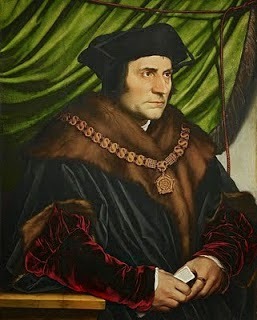 On May 16, 1532, Sir Thomas More resigned as Chancellor of England, succeeded by Thomas Audley. More concluded that he could not influence Henry VIII anymore. He might have hoped for some peace and quiet, but Henry and Cromwell wanted his approval and benediction. More did not attend the coronation of Anne Boleyn; in 1533 and 1534 he was accused of first, accepting bribes, and second of supporting Elizabeth Barton, the Nun of Kent. The first accusation was ridiculous and the second easily disposed of. Nevertheless, he ended up in the Tower of London in 1534 while the government continued to pressure him to take the Oaths of Supremacy and Succession. As he complained of chest pains before, his health deteriorated while in the Tower.
On May 16, 1532, Sir Thomas More resigned as Chancellor of England, succeeded by Thomas Audley. More concluded that he could not influence Henry VIII anymore. He might have hoped for some peace and quiet, but Henry and Cromwell wanted his approval and benediction. More did not attend the coronation of Anne Boleyn; in 1533 and 1534 he was accused of first, accepting bribes, and second of supporting Elizabeth Barton, the Nun of Kent. The first accusation was ridiculous and the second easily disposed of. Nevertheless, he ended up in the Tower of London in 1534 while the government continued to pressure him to take the Oaths of Supremacy and Succession. As he complained of chest pains before, his health deteriorated while in the Tower. 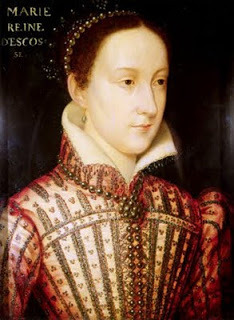 On May 16, 1568, Mary Stuart, the deposed Queen of Scotland left that country after losing the Battle of Langside and escaped to England. She hoped for some support from Elizabeth Tudor to regain her throne. Instead, she was moved from castle to castle (Carlisle Castle, Bolton Castle, Tutbury, and Sheffield) under different degrees of comfort and activity while a trial was held to determine her guilt in her second husband, Henry Stuart, Lord Darnley's death. The trial ended in a strange verdict and she was neither declared guilty or innocent. The only thing that was certain is that she was not going to return to Scotland as Queen. Mary was held under house arrest and became the focus of plots to remove Elizabeth from the throne of England. As she had been a very active person, riding and hunting, the enforced inactivity wore on her.
On May 16, 1568, Mary Stuart, the deposed Queen of Scotland left that country after losing the Battle of Langside and escaped to England. She hoped for some support from Elizabeth Tudor to regain her throne. Instead, she was moved from castle to castle (Carlisle Castle, Bolton Castle, Tutbury, and Sheffield) under different degrees of comfort and activity while a trial was held to determine her guilt in her second husband, Henry Stuart, Lord Darnley's death. The trial ended in a strange verdict and she was neither declared guilty or innocent. The only thing that was certain is that she was not going to return to Scotland as Queen. Mary was held under house arrest and became the focus of plots to remove Elizabeth from the throne of England. As she had been a very active person, riding and hunting, the enforced inactivity wore on her.Both of them were finally brought to trial--Thomas More at Westminster Hall; Mary at Fotheringay Castle. Both St. Thomas More and Mary, Queen of Scots ended their lives kneeling before blocks of wood, waiting for the executioner's blow to fall--More on July 6, 1535 and Mary on February 8, 1587.
Published on May 15, 2014 23:00
The Ordinariate Restart, Part II
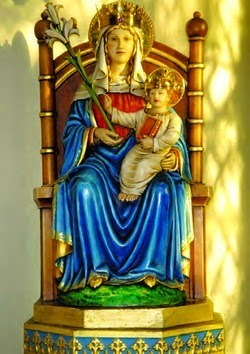 In addition to the "Called to be One" effort at evangelization and growth of the Personal Ordinariate of Our Lady of Walsingham this September, there will be an "Ordinariate Festival". The New Liturgical Movement blog posts the details:
In addition to the "Called to be One" effort at evangelization and growth of the Personal Ordinariate of Our Lady of Walsingham this September, there will be an "Ordinariate Festival". The New Liturgical Movement blog posts the details:The Personal Ordinariate of Our Lady of Walsingham is to hold its first "Ordinariate Festival" in September this year. The guest of honour will be Cardinal Vincent Nichols, Archbishop of Westminster and head of the Roman Catholic Church in England and Wales, who will deliver an address on the how the Ordinariate fits in to the life and mission of the wider Catholic Church in the United Kingdom. The festival, which will run over the weekend of Friday 19 September to Sunday 21 September, is expected to be the biggest gathering of clergy and faithful from the more than forty Ordinariate groups across the country, since the Ordinariate was established in the UK in January 2011.
The proceedings will begin on the evening of Friday 19 September with a reception at the home of the Ordinary, the Rt Revd Mgr Keith Newton and his wife, Gill, in Golden Square, Soho, which adjoins the Ordinariate's central church, Our Lady of the Assumption and St Gregory, Warwick Street. The main events will be on Saturday, 20 September, organised around Mass in Westminster Cathedral at 12.30. Before the Mass, Ordinariate groups will give presentations on aspects of their mission. In the afternoon Cardinal Nichols and the Ordinary will speak. The Ordinariate clergy and faithful will be encouraged to stay on in London so that they can attend the 103.30 Sung Mass on Sunday 21 September at Our Lady of the Assumption and St Gregory.
Read the rest here.
The Ordinary of the Ordinariate, Monsignor Keith Newton, has made his own comments on the role of his special "diocese" in re-evangelizing England (which even the former Archbishop of Canterbury Rowan Williams has admitted is not a Christian country--in spite of an establishment church!) in the Friends of the Ordinariate Newsletter:
The Ordinary of the Personal Ordinariate of Our Lady of Walsingham Monsignor Keith Newton, has said the Ordinariate has a unique part to play in the New Evangelisation because of the way it "brings into modern Catholicism an ancient British expression of Christian life".
Writing in the Friends of the Ordinariate's Eastertide Newsletter, Mgr Newton quotes the words of Pope Francis in his Apostolic Exhortation, Evangelii Gaudium, in which the Holy Father says that it is through the diversity of the countless people who have received and passed on the grace of faith "in the language of their own culture" that the Church expresses her genuine catholicity and shows forth the "beauty of her varied face".
Mgr Newton writes: "For centuries, a particularly English and ancient culture of Catholic truth has been treasured and guarded within the Church of England, while Anglicanism itself is interwoven into the culture of British society". The Ordinariate, Mgr Newton goes on, is a tool of profound importance in the New Evangelisation because it provides a bridge between the Catholic Church and deeply rooted elements of British religious culture.
Read the rest of his comments here in the newsletter.
Published on May 15, 2014 22:30
May 14, 2014
The Ordinariate Restart
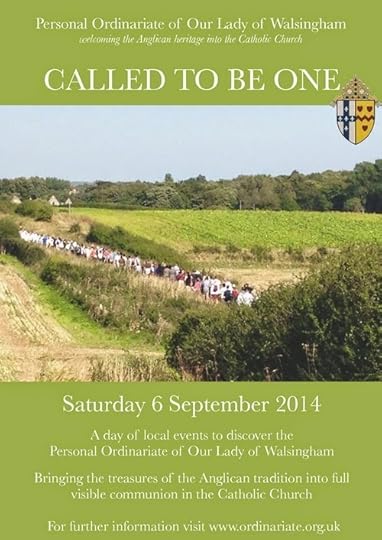 The Ordinary of the Our Lady of Walsingham Personal Ordinariate has called for a restart of the Ordinariate. The Tablet reports on his comments at the Chrism Mass this past Holy Week:
The Ordinary of the Our Lady of Walsingham Personal Ordinariate has called for a restart of the Ordinariate. The Tablet reports on his comments at the Chrism Mass this past Holy Week:The leader of the ordinariate has lamented the lack of growth of the group, set up in 2011 to allow former Anglicans to enter Communion with the Catholic Church.
Mgr Keith Newton, the ordinary of the Personal Ordinariate of Our Lady of Walsingham, said more must be done to boost the numbers in the canonical structure, established under Pope Benedict XVI to allow Anglicans become Catholics while preserving their “Anglican patrimony”.
In a Chrism Mass homily on Monday, Mgr Newton conceded: “We must be honest and say the ordinariate has not grown as much as we hoped it might. The vision has not been caught … We must communicate our message much more widely and with more vigour and enthusiasm.”
The group, which has around 85 priests and 1,500 lay members, is preparing an “exploration day” on 6 September named “Called to be One”. Each “cluster” of ordinariate branches should “organise an event and invite those who might be interested to learn more about that vision for unity and truth in communion with the successor of Peter,” Mgr Newton said.
Those who led the Ordinariate in formation must have had an idea of how many from the Anglican Church could be coming, and know that many of those haven't come in to what Blessed John Henry Newman called "the one true fold of Christ". Therefore, in spite of all the excellent work achieved to date (the liturgy formation, a central church in London, various programs like the annual pilgrimage to Walsingham, The Portal newsletter, etc.), the Ordinariate needs to sustain growth to remain alive.
From the Ordinariate website:
The Personal Ordinariate of Our Lady of Walsingham has announced the details of a major evangelisation initiative planned for September this year. Saturday, 6 September has been set aside as an "exploration day" when Ordinariate groups will organise local activities designed for people who are not currently part of the Ordinariate, but who wish to learn more about it. Among those invited to the events, which will be widely publicised, will be Anglicans - both lapsed and practising - who might be interested in the vision for truth and unity in communion with the successor of Peter which the Ordinariate offers. Typically, local events might include an address, a question and answer session with input from local lay members of the Ordinariate, refreshments and Evensong and/or Benediction of the Blessed Sacrament.
Speaking at the Ordinariate's Chrism Mass on 14 April, the Ordinary of the Ordinariate, Mgr Keith Newton, said the exploration day, which has been named "Called to be One", was part of renewed efforts on the Ordinariate's part to communicate its message "much more widely and with more vigour and enthusiasm".
Mgr Newton went on to remind the congregation of the vision that was set out in the Apostolic Constitution, Anglicanorum Coetibus. He said: "It is to maintain the liturgical, spiritual and pastoral traditions of the Anglican Communion within the Catholic Church, as a precious gift nourishing the faith of the members of the Ordinariate and as a treasure to be shared. It is this vision which we need to foster within our own communities and which we need to communicate, both with our fellow Catholics... but also with our friends and former colleagues in the Church of England and equally Anglicans who have lapsed from the practice of the Faith. It is an important work of ecumenism".
For the success of this program: Our Lady of Walsingham, pray for us! Blessed John Henry Newman, pray for us!
Published on May 14, 2014 22:30
May 13, 2014
My Easter Mystagogy
Now that I have finished reading Volume I of Pope Benedict XVI's Jesus of Nazareth trilogy, I am reading an old book that is experiencing quite a revival: Romano Guardini's Meditations Before Mass. I have the 1959 "A Newman Paperback" from The Newman Press in Westminster, Maryland with me to read. I also have the hardcover edition Sophia Institute Press (1993) on the shelf:
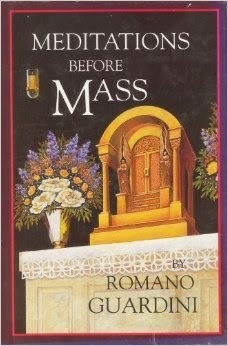
Sophia has reissued Guardini's book in a blue paperback (there's also an ebook) with an introduction by Archbishop Samuel Aquila:
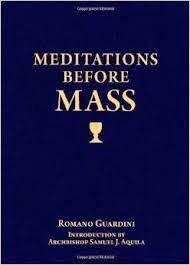
The profound wisdom found in this Romano Guardini classic will help you to quiet your soul, concentrate your mind, and grow more receptive to God's grace in the Holy Mass.
Written for ordinary Catholics who are struggling to become closer to Christ,Meditations Before Mass is full of wisdom and yet offers practical, straightforward advice that will help you overcome distractions and restlessness while leading you into a more enriching experience when you enter into Holy Communion with God.
Over fifty years ago, Msgr. Romano Guardini resolved to help his parishioners move beyond the petty hindrances to full participation in the Mass—hindrances to which we are all prone. Just before Mass each Sunday, he gave a brief talk on some aspect of the Mass, teaching them week by week, topic by topic, how to prepare themselves to participate more prayerfully.
So helpful were these 32 talks that they were soon published and have since been reprinted countless times in numerous countries and languages, helping generations of Catholics to deepen their devotion during Mass.
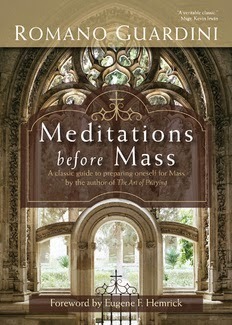
And Ave Maria Press has issued their own edition (also with an ebook), with an introduction by Reverend Eugene F. Hemrick:
A treasury of spiritual wisdom on how to prepare your mind, body, and heart for Mass from one of the twentieth century’s great theologians, Meditations before Mass is Romano Guardini’s smart and beautiful guide to spiritual preparation for the source and summit of Christian worship.
Meditations before Mass is a wise, pastoral, and timeless classic on preparing for Mass—it is an example of twentieth-century theologian Romano Guardini at his very best. Meditations before Mass was written before Vatican II, but its relevance has endured over the past sixty years. Not a “how to” book for either the old or the new Roman Rite, it is instead a spiritual feast for the mind and heart, and a guide for modern people who wish to make sense of the Church’s feasts and liturgies. Meditations before Mass has helped thousands of readers participate more fully in Christian liturgy and continues to do so today.
In the early 1990's Sophia Institute Press began to re-issue many titles by Monsignor Romano Guardini, and I (just as I had with Thomas B. Costain's books) bought and read them all:
The Inner Life of JesusThe Rosary of Our LadyLiving the Drama of FaithAnd the Word Dwelt Upon UsThe Art of Praying
Then I found more:
The LordThe End of the Modern WorldSacred SignsThe Spirit of the Liturgy
The last title, you might recall, was re-used by Joseph Cardinal Ratzinger in 2000, paying homage to Guardini's great efforts in the renewal of liturgy before the Second Vatican Council. As then Cardinal Ratzinger stated in the foreword to his book The Spirit of the Liturgy, "My purpose here is to assist this renewal of understanding of the Liturgy. Its basic intentions coincide with what Guardini wanted to achieve. The only difference is that I have had to translate what Guardini did at the end of the First World War, in a totally different historical situation, into the context of our present-day questions, hopes and dangers. Like Guardini, I am not attempting to involve myself with scholarly discussion and research. I am simply offering an aid to the understanding of the faith and to the right way to give the faith its central form of expression in the Liturgy."

Sophia has reissued Guardini's book in a blue paperback (there's also an ebook) with an introduction by Archbishop Samuel Aquila:

The profound wisdom found in this Romano Guardini classic will help you to quiet your soul, concentrate your mind, and grow more receptive to God's grace in the Holy Mass.
Written for ordinary Catholics who are struggling to become closer to Christ,Meditations Before Mass is full of wisdom and yet offers practical, straightforward advice that will help you overcome distractions and restlessness while leading you into a more enriching experience when you enter into Holy Communion with God.
Over fifty years ago, Msgr. Romano Guardini resolved to help his parishioners move beyond the petty hindrances to full participation in the Mass—hindrances to which we are all prone. Just before Mass each Sunday, he gave a brief talk on some aspect of the Mass, teaching them week by week, topic by topic, how to prepare themselves to participate more prayerfully.
So helpful were these 32 talks that they were soon published and have since been reprinted countless times in numerous countries and languages, helping generations of Catholics to deepen their devotion during Mass.

And Ave Maria Press has issued their own edition (also with an ebook), with an introduction by Reverend Eugene F. Hemrick:
A treasury of spiritual wisdom on how to prepare your mind, body, and heart for Mass from one of the twentieth century’s great theologians, Meditations before Mass is Romano Guardini’s smart and beautiful guide to spiritual preparation for the source and summit of Christian worship.
Meditations before Mass is a wise, pastoral, and timeless classic on preparing for Mass—it is an example of twentieth-century theologian Romano Guardini at his very best. Meditations before Mass was written before Vatican II, but its relevance has endured over the past sixty years. Not a “how to” book for either the old or the new Roman Rite, it is instead a spiritual feast for the mind and heart, and a guide for modern people who wish to make sense of the Church’s feasts and liturgies. Meditations before Mass has helped thousands of readers participate more fully in Christian liturgy and continues to do so today.
In the early 1990's Sophia Institute Press began to re-issue many titles by Monsignor Romano Guardini, and I (just as I had with Thomas B. Costain's books) bought and read them all:
The Inner Life of JesusThe Rosary of Our LadyLiving the Drama of FaithAnd the Word Dwelt Upon UsThe Art of Praying
Then I found more:
The LordThe End of the Modern WorldSacred SignsThe Spirit of the Liturgy
The last title, you might recall, was re-used by Joseph Cardinal Ratzinger in 2000, paying homage to Guardini's great efforts in the renewal of liturgy before the Second Vatican Council. As then Cardinal Ratzinger stated in the foreword to his book The Spirit of the Liturgy, "My purpose here is to assist this renewal of understanding of the Liturgy. Its basic intentions coincide with what Guardini wanted to achieve. The only difference is that I have had to translate what Guardini did at the end of the First World War, in a totally different historical situation, into the context of our present-day questions, hopes and dangers. Like Guardini, I am not attempting to involve myself with scholarly discussion and research. I am simply offering an aid to the understanding of the faith and to the right way to give the faith its central form of expression in the Liturgy."
Published on May 13, 2014 22:30
May 12, 2014
The Black Mass at Harvard and the English Reformation
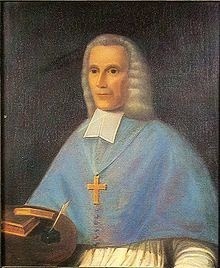 Catholic print and social media have been reporting and commenting frequently the last several days about the planned, but cancelled, Black Mass to be "celebrated" at Harvard University, sponsored by the Harvard Extension Cultural Studies Club. First it was announced that the event organizers had obtained a Consecrated Host, which to Catholics meant that the Real Presence of Jesus, Body, Blood, Soul, and Divinity was to be desecrated in the mockery of the Black Mass--then they backed off from that claim. According to the updated accounts, the venue that was to "host" this educational event, "The Queen's Head" pub cancelled the reservation. Harvard's president descried the campus organization's plan to present the Black Mass but declined to cancel the event herself--she announced her intention to attend the Holy Hour and Benediction scheduled at St. Paul's Parish on Harvard Square. The Harvard Crimson published a student editorial against the event, while the organizers tried to have it both ways--yes, we're mocking Catholic beliefs but we don't really mean anything by it. This controversy has certainly rallied Catholics at Harvard to defend the Real Presence and make reparation for this abuse of our Faith.
Catholic print and social media have been reporting and commenting frequently the last several days about the planned, but cancelled, Black Mass to be "celebrated" at Harvard University, sponsored by the Harvard Extension Cultural Studies Club. First it was announced that the event organizers had obtained a Consecrated Host, which to Catholics meant that the Real Presence of Jesus, Body, Blood, Soul, and Divinity was to be desecrated in the mockery of the Black Mass--then they backed off from that claim. According to the updated accounts, the venue that was to "host" this educational event, "The Queen's Head" pub cancelled the reservation. Harvard's president descried the campus organization's plan to present the Black Mass but declined to cancel the event herself--she announced her intention to attend the Holy Hour and Benediction scheduled at St. Paul's Parish on Harvard Square. The Harvard Crimson published a student editorial against the event, while the organizers tried to have it both ways--yes, we're mocking Catholic beliefs but we don't really mean anything by it. This controversy has certainly rallied Catholics at Harvard to defend the Real Presence and make reparation for this abuse of our Faith.The name of the pub originally set to host the Black Mass--and the fact that a pub was initially chosen for the site--called to mind some aspects of English Reformation history. The Queen's Head in Cambridge, Mass., was named for The Queen's Head pub at Southwark in London, founded by John Harvard's family; he is honored in Southwark Cathedral, the former Catholic church, now Anglican, where he was baptized. Harvard willed his library and half his estate to found a college in the Massachusetts's Bay Colony; he was a Puritan minister and his family had connections with William Shakespeare.
But the significance of the location of the Black Mass re-enactment goes deeper, I think. The true Catholic Mass was indeed celebrated in pubs, secretly, during the Penal/Recusant period in England, which lasted from the reign of Elizabeth I to the late eighteenth century. Bishop Richard Challoner celebrated Mass at The Ship Tavern as Vicar Apostolic--the pub's website gets its history wrong, indicating that Henry VIII had made the Catholic Mass illegal during his reign, when of course he still attended Catholic Mass. Under the Elizabethan recusancy laws, lay attendance at Catholic Mass was a felony; the presence of a Catholic priest in England an act of treason, and both "crimes" were punishable by execution. John Harvard probably would have viewed the celebration of the Catholic Mass at his family pub an act of idolatry--but he also would have been appalled at the worship of Satan in a pub on the campus of the university that bears his name.
Published on May 12, 2014 22:30
The Black Mass at Harvard
 Catholic print and social media have been reporting and commenting frequently the last several days about the planned, but cancelled, Black Mass to be "celebrated" at Harvard University, sponsored by the Harvard Extension Cultural Studies Club. First it was announced that the event organizers had obtained a Consecrated Host, which to Catholics meant that the Real Presence of Jesus, Body, Blood, Soul, and Divinity was to be desecrated in the mockery of the Black Mass--then they backed off from that claim. According to the updated accounts, the venue that was to "host" this educational event, "The Queen's Head" pub cancelled the reservation. Harvard's president descried the campus organization's plan to present the Black Mass but declined to cancel the event herself--she announced her intention to attend the Holy Hour and Benediction scheduled at St. Paul's Parish on Harvard Square. The Harvard Crimson published a student editorial against the event, while the organizers tried to have it both ways--yes, we're mocking Catholic beliefs but we don't really mean anything by it. This controversy has certainly rallied Catholics at Harvard to defend the Real Presence and make reparation for this abuse of our Faith.
Catholic print and social media have been reporting and commenting frequently the last several days about the planned, but cancelled, Black Mass to be "celebrated" at Harvard University, sponsored by the Harvard Extension Cultural Studies Club. First it was announced that the event organizers had obtained a Consecrated Host, which to Catholics meant that the Real Presence of Jesus, Body, Blood, Soul, and Divinity was to be desecrated in the mockery of the Black Mass--then they backed off from that claim. According to the updated accounts, the venue that was to "host" this educational event, "The Queen's Head" pub cancelled the reservation. Harvard's president descried the campus organization's plan to present the Black Mass but declined to cancel the event herself--she announced her intention to attend the Holy Hour and Benediction scheduled at St. Paul's Parish on Harvard Square. The Harvard Crimson published a student editorial against the event, while the organizers tried to have it both ways--yes, we're mocking Catholic beliefs but we don't really mean anything by it. This controversy has certainly rallied Catholics at Harvard to defend the Real Presence and make reparation for this abuse of our Faith.The name of the pub originally set to host the Black Mass--and the fact that a pub was initially chosen for the site--called to mind some aspects of English Reformation history. The Queen's Head in Cambridge, Mass., was named for The Queen's Head pub at Southwark in London, founded by John Harvard, who is honored in Southwark Cathedral, the former Catholic church, now Anglican. Harvard willed his library and half his estate to found a college in the Massachusetts's Bay Colony; he was a Puritan minister and his family had connections with William Shakespeare.
But the significance of the location of the Black Mass re-enactment goes deeper, I think. The true Catholic Mass was indeed celebrated in pubs, secretly, during the Penal/Recusant period in England, which lasted from the reign of Elizabeth I to the late eighteenth century. Bishop Richard Challoner celebrated Mass at The Ship Tavern as Vicar Apostolic--the pub's website gets its history wrong, indicating that Henry VIII had made the Catholic Mass illegal during his reign, when of course he still attended Catholic Mass. Under the Elizabethan recusancy laws, lay attendance at Catholic Mass was a felony; the presence of a Catholic priest in England an act of treason, and both "crimes" were punishable by execution.
Published on May 12, 2014 22:30
May 10, 2014
Stations of the Cross in the Easter Season
The Church of the Blessed Sacrament recently acquired and restored a set of Stations of the Cross that had once been in the Cathedral of the Immaculate Conception here in Wichita, Kansas. Some parishioners hung them in the church on Friday last week and I went to pray the Stations of the Cross that afternoon. They replaced a set of stations that depicted just the face of Jesus at each station--so where before we had a rather minimalist interpretation of the Way of the Cross, now we have a set of dramatic vignettes. These new/old stations show each scene with Jesus at the center, of course, but with many other characters in the background or the foreground.
After I prayed the Stations, I went back around to take some pictures in the available light of the late afternoon (in a church on a north/south axis) with my husband's Canon S95. The pictures that turned out best, because of the angle at which I was taking them (perhaps four feet above my head), were those in which I zoomed in on a portion of the scene. As I viewed and re-viewed these stations, I noticed these details. From the Seventh Station: Jesus Falls the Second Time, see the dog growling at Jesus:
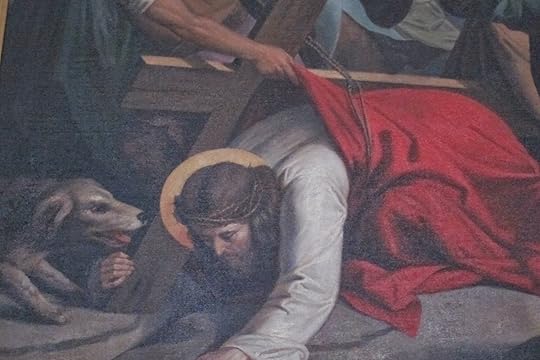 This was in the darkest part of the church in the late afternoon so it's a little grainy. From the Eighth Station: Jesus Meets the Women of Jerusalem: He stretches out His hand in blessing even as the soldiers are moving on from this meeting:
This was in the darkest part of the church in the late afternoon so it's a little grainy. From the Eighth Station: Jesus Meets the Women of Jerusalem: He stretches out His hand in blessing even as the soldiers are moving on from this meeting:
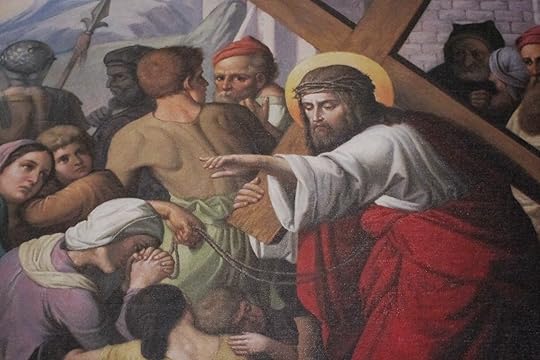
The sky in the background of the Tenth Station, Jesus is Stripped of His Garments, is beautiful:
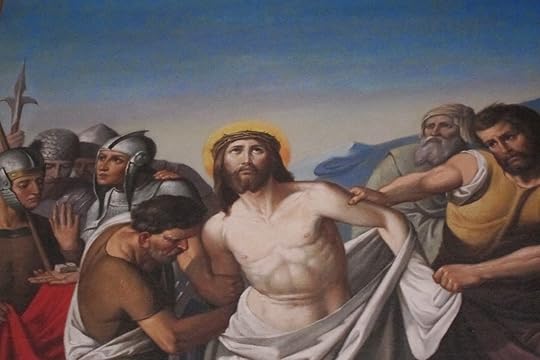
Notice the argument beginning over Pilate's sign to be placed above Jesus on the Cross (do not say that "He is King of the Jews"; say that "He Said He was King of the Jews"--and Pilate's reply, What I have written, I have written) in the background of the Eleventh Station as Jesus is Nailed to the Cross:
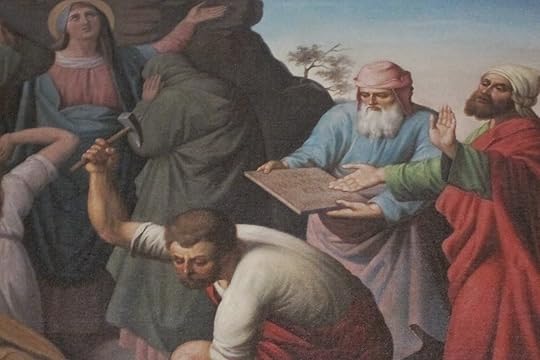
Joseph of Arimathea and Nicodemus consult in the background as the Blessed Virgin Mary, St. John, and St. Mary Magdalen mourn the death of Jesus in the Deposition station (the Thirteenth Station):
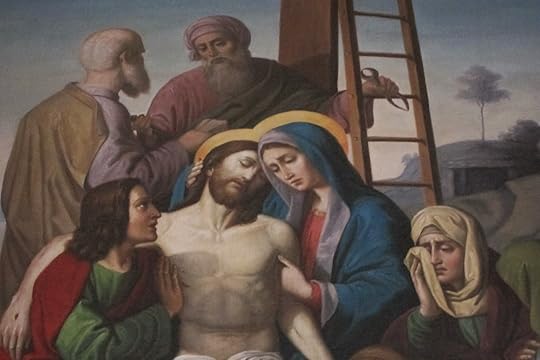 I think these Stations of the Cross complement the stained glass windows above them which depict different parables from the Gospels. The general style of garments and the colors in both the windows and the paintings match well. It can seem strange to pray the Stations of the Cross and meditate on Christ's Passion and Death during the Easter Season, but it is true that without Good Friday there can be no Easter Sunday and without Easter Sunday, Good Friday has no meaning or purpose. Throughout the Easter Season, the readings from the Acts of the Apostles describe how St. Peter and the Apostles, and St. Paul preach how Jesus was crucified, died, and rose from the dead--and is alive, the Savior of the world!
I think these Stations of the Cross complement the stained glass windows above them which depict different parables from the Gospels. The general style of garments and the colors in both the windows and the paintings match well. It can seem strange to pray the Stations of the Cross and meditate on Christ's Passion and Death during the Easter Season, but it is true that without Good Friday there can be no Easter Sunday and without Easter Sunday, Good Friday has no meaning or purpose. Throughout the Easter Season, the readings from the Acts of the Apostles describe how St. Peter and the Apostles, and St. Paul preach how Jesus was crucified, died, and rose from the dead--and is alive, the Savior of the world!
After I prayed the Stations, I went back around to take some pictures in the available light of the late afternoon (in a church on a north/south axis) with my husband's Canon S95. The pictures that turned out best, because of the angle at which I was taking them (perhaps four feet above my head), were those in which I zoomed in on a portion of the scene. As I viewed and re-viewed these stations, I noticed these details. From the Seventh Station: Jesus Falls the Second Time, see the dog growling at Jesus:
 This was in the darkest part of the church in the late afternoon so it's a little grainy. From the Eighth Station: Jesus Meets the Women of Jerusalem: He stretches out His hand in blessing even as the soldiers are moving on from this meeting:
This was in the darkest part of the church in the late afternoon so it's a little grainy. From the Eighth Station: Jesus Meets the Women of Jerusalem: He stretches out His hand in blessing even as the soldiers are moving on from this meeting:
The sky in the background of the Tenth Station, Jesus is Stripped of His Garments, is beautiful:

Notice the argument beginning over Pilate's sign to be placed above Jesus on the Cross (do not say that "He is King of the Jews"; say that "He Said He was King of the Jews"--and Pilate's reply, What I have written, I have written) in the background of the Eleventh Station as Jesus is Nailed to the Cross:

Joseph of Arimathea and Nicodemus consult in the background as the Blessed Virgin Mary, St. John, and St. Mary Magdalen mourn the death of Jesus in the Deposition station (the Thirteenth Station):
 I think these Stations of the Cross complement the stained glass windows above them which depict different parables from the Gospels. The general style of garments and the colors in both the windows and the paintings match well. It can seem strange to pray the Stations of the Cross and meditate on Christ's Passion and Death during the Easter Season, but it is true that without Good Friday there can be no Easter Sunday and without Easter Sunday, Good Friday has no meaning or purpose. Throughout the Easter Season, the readings from the Acts of the Apostles describe how St. Peter and the Apostles, and St. Paul preach how Jesus was crucified, died, and rose from the dead--and is alive, the Savior of the world!
I think these Stations of the Cross complement the stained glass windows above them which depict different parables from the Gospels. The general style of garments and the colors in both the windows and the paintings match well. It can seem strange to pray the Stations of the Cross and meditate on Christ's Passion and Death during the Easter Season, but it is true that without Good Friday there can be no Easter Sunday and without Easter Sunday, Good Friday has no meaning or purpose. Throughout the Easter Season, the readings from the Acts of the Apostles describe how St. Peter and the Apostles, and St. Paul preach how Jesus was crucified, died, and rose from the dead--and is alive, the Savior of the world!
Published on May 10, 2014 22:30
May 8, 2014
The Tsar's Four Daughters: OTMA
During David Lean's epic Doctor Zhivago, the doctor/poet and his family escape the city for their country estate (but have to live in the servant's quarters because the local Communist organization has claimed the manor house for the People and the Party). They receive a newspaper with the story about the execution of the Tsar and his entire family and wonder why all of them had to die. Doctor Zhivago states that because it makes it clear there's no going back.
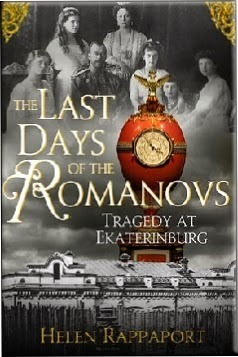 I have read and re-read Helen Rappaport's recounting of the last days of the family at Ekaterinburg and the eventual discovery of their bodies, confirmation of their DNA matches, and canonization as martyrs in the Russian Orthodox Church. In fact, it was the depth of religious feeling that Rappaport uncovered in the family, and in the four daughters especially, that impressed me. Rappaport tells the story of how the family attended their final Divine Liturgy; the priest who sang the service recounted an extraordinary event and changes in the family:
I have read and re-read Helen Rappaport's recounting of the last days of the family at Ekaterinburg and the eventual discovery of their bodies, confirmation of their DNA matches, and canonization as martyrs in the Russian Orthodox Church. In fact, it was the depth of religious feeling that Rappaport uncovered in the family, and in the four daughters especially, that impressed me. Rappaport tells the story of how the family attended their final Divine Liturgy; the priest who sang the service recounted an extraordinary event and changes in the family:
According to the liturgy governing a low Mass, at a determined moment, the following prayer must be read: May the souls of the departed rest in peace with Thy saints. I do not know why he did it, but my deacon, instead of merely reading the prayer, began to chant it. [This prayer is never sung except at funerals.] I followed suit, though somewhat irritated at his violation of the canons. We had barely begun when we heard, behind us, the noise of the whole imperial family throwing themselves on their knees.... At the end of the service they all approached to kiss the Cross and the deacon gave the Blessed Bread to both Emperor and Empress.... The deacon and I left in silence.... Suddenly, in front of the School of Fine Arts, the deacon said to me, Do you know, something has happened to them. As his words corresponded exactly to what I was, thinking, I stopped and asked him why he thought so. I am sure, he said; they seem so changed, and not one of them sang today. He was right, because for the first time, on July 14, not one of the Romanovs accompanied us by singing.
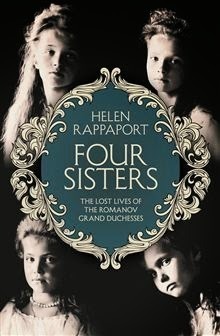 In her new book, Four Sisters: The Lost Lives of the Romanov Grand Duchesses, Helen Rappaport focuses on Olga, Tatiana, Maria, and Anastasia, the young women who were horribly murdered in the cellar at Ekaterinburg on July 7, 1918. The author was interviewed in the April issue of the BBC History Magazine and commented on how devoutly Christian the four sisters were.
In her new book, Four Sisters: The Lost Lives of the Romanov Grand Duchesses, Helen Rappaport focuses on Olga, Tatiana, Maria, and Anastasia, the young women who were horribly murdered in the cellar at Ekaterinburg on July 7, 1918. The author was interviewed in the April issue of the BBC History Magazine and commented on how devoutly Christian the four sisters were.
From the author's website:
The four captivating young Romanov sisters were perhaps the most photographed and talked about young royals of the early twentieth century. And with good reason; they were much admired for their happy dispositions, their looks, and their devotion to their parents and sick brother. From an early age they were inevitably at the centre of unceasing gossip about the dynastic marriages they might make. But who were they really beyond the saccharine image perpetuated by those now familiar photographs of them as pretty girls in white dresses and big hats? What were their personal hopes, dreams and aspirations and how did they interact with each other and with their parents? What was life really like within the highly insular Imperial Family and how did they really feel about their mother’s obsessive and all consuming love for their spoilt brother Alexey?
Over the years, the story of the four Romanov sisters and their tragic end in a basement at Ekaterinburg in 1918 has clouded our view of them, leading to a mass of sentimental and idealized hagiography. They are too often seen merely as set dressing, the beautiful but innocuous background to the bigger, more dramatic story of their parents – Russia’s last Tsar and Tsarina, Nicholas and Alexandra. They are perceived as lovely, desirable and living charmed lives. But the truth is somewhat different.
For most of their short lives the four Romanov sisters were beautiful birds in a gilded cage, shut away at their palaces at Tsarskoe Selo or Livadia as a reaction to the fear of terrorist attacks on the Imperial Family. In reality the sisters had few friends and were largely cut off from the real world outside and the normal life experiences of other girls – that is, until everything changed in 1914. Suddenly, with Russia’s entry into the war, the girls had to grow up fast.
In a deliberate echo of the title of Chekhov’s play, Four Sisters sets out to capture the joy as well as the insecurities and poignancy of those young lives against the backdrop of the dying days of late Imperial Russia, drawing on previously unseen and unpublished letters, diaries and memoirs of the period.
The book is also the subject of a forthcoming documentary ‘Russia’s Lost Princesses’, which the author has been working on with Silver River Productions for BBC2. A transmission date will be announced soon.
The book is scheduled for release in the USA in June from St. Martin's Press (with a different, less Chekhovian title: The Romanov Sisters). It looks like an interesting book, although it seems from reviews in the U.K. that the book reveals more about the Tsarina, Alexandra Feodorovna and her control over the family, than it does about the four daughters (between 17 and 22 when they were murdered). That's certainly the view of the reviewer in The Telegraph. The reviewer in The Guardian notes the same "family dynamic" but also that the entire royal family would have been so much happier if they hadn't been reigning over the Russian Empire (the Tsar's dream is to be a farmer in England!):
Olga, Tatiana, Maria and Anastasia are bright, wilful girls who are devoted to their parents and to their precious little brother Alexey. The tsarevitch appeared just when Nicholas was despairing of ever providing the country with a male heir, and the girls grow up conspiring to keep his constantly life-endangering haemophilia a secret from the nation. Anxious to protect her son and fearing the moral iniquity of St Petersburg society, Alexandra keeps her children secluded in their countryside palace. The "girlies" (as Alexandra persists in calling them) long for news of "outside life" but have little interest in court intrigues. They are delighted when they can wander around an English village with money of their own to spend.
For all four sisters, the ideal life would be one of quiet middle-class domesticity with a soldier husband. Infantilised by Alexandra, they are allowed to run wild with the soldiers who escort them on their annual holiday to Crimea. Even as teenagers, they play boisterous games of hide and seek with the handsome young officers; at one stage 10 people crammed into a wardrobe. Everything changes in the first world war when Alexandra, Olga and Tatiana train as nurses (typically modest, they take the titles of Sister Romanova numbers 1, 2 and 3). Now at last the girls have the contact with the outside world they have longed for as they change dressings and help with operations. But again it's the ordinariness they most love. "It's only at our hospital that we feel comfortable and at ease," Olga tells one of her patients.
As both reviewers note, since we know the end of the story, these young, beautiful lives are very sad in their promise and its thwarting.
 I have read and re-read Helen Rappaport's recounting of the last days of the family at Ekaterinburg and the eventual discovery of their bodies, confirmation of their DNA matches, and canonization as martyrs in the Russian Orthodox Church. In fact, it was the depth of religious feeling that Rappaport uncovered in the family, and in the four daughters especially, that impressed me. Rappaport tells the story of how the family attended their final Divine Liturgy; the priest who sang the service recounted an extraordinary event and changes in the family:
I have read and re-read Helen Rappaport's recounting of the last days of the family at Ekaterinburg and the eventual discovery of their bodies, confirmation of their DNA matches, and canonization as martyrs in the Russian Orthodox Church. In fact, it was the depth of religious feeling that Rappaport uncovered in the family, and in the four daughters especially, that impressed me. Rappaport tells the story of how the family attended their final Divine Liturgy; the priest who sang the service recounted an extraordinary event and changes in the family:According to the liturgy governing a low Mass, at a determined moment, the following prayer must be read: May the souls of the departed rest in peace with Thy saints. I do not know why he did it, but my deacon, instead of merely reading the prayer, began to chant it. [This prayer is never sung except at funerals.] I followed suit, though somewhat irritated at his violation of the canons. We had barely begun when we heard, behind us, the noise of the whole imperial family throwing themselves on their knees.... At the end of the service they all approached to kiss the Cross and the deacon gave the Blessed Bread to both Emperor and Empress.... The deacon and I left in silence.... Suddenly, in front of the School of Fine Arts, the deacon said to me, Do you know, something has happened to them. As his words corresponded exactly to what I was, thinking, I stopped and asked him why he thought so. I am sure, he said; they seem so changed, and not one of them sang today. He was right, because for the first time, on July 14, not one of the Romanovs accompanied us by singing.
 In her new book, Four Sisters: The Lost Lives of the Romanov Grand Duchesses, Helen Rappaport focuses on Olga, Tatiana, Maria, and Anastasia, the young women who were horribly murdered in the cellar at Ekaterinburg on July 7, 1918. The author was interviewed in the April issue of the BBC History Magazine and commented on how devoutly Christian the four sisters were.
In her new book, Four Sisters: The Lost Lives of the Romanov Grand Duchesses, Helen Rappaport focuses on Olga, Tatiana, Maria, and Anastasia, the young women who were horribly murdered in the cellar at Ekaterinburg on July 7, 1918. The author was interviewed in the April issue of the BBC History Magazine and commented on how devoutly Christian the four sisters were.From the author's website:
The four captivating young Romanov sisters were perhaps the most photographed and talked about young royals of the early twentieth century. And with good reason; they were much admired for their happy dispositions, their looks, and their devotion to their parents and sick brother. From an early age they were inevitably at the centre of unceasing gossip about the dynastic marriages they might make. But who were they really beyond the saccharine image perpetuated by those now familiar photographs of them as pretty girls in white dresses and big hats? What were their personal hopes, dreams and aspirations and how did they interact with each other and with their parents? What was life really like within the highly insular Imperial Family and how did they really feel about their mother’s obsessive and all consuming love for their spoilt brother Alexey?
Over the years, the story of the four Romanov sisters and their tragic end in a basement at Ekaterinburg in 1918 has clouded our view of them, leading to a mass of sentimental and idealized hagiography. They are too often seen merely as set dressing, the beautiful but innocuous background to the bigger, more dramatic story of their parents – Russia’s last Tsar and Tsarina, Nicholas and Alexandra. They are perceived as lovely, desirable and living charmed lives. But the truth is somewhat different.
For most of their short lives the four Romanov sisters were beautiful birds in a gilded cage, shut away at their palaces at Tsarskoe Selo or Livadia as a reaction to the fear of terrorist attacks on the Imperial Family. In reality the sisters had few friends and were largely cut off from the real world outside and the normal life experiences of other girls – that is, until everything changed in 1914. Suddenly, with Russia’s entry into the war, the girls had to grow up fast.
In a deliberate echo of the title of Chekhov’s play, Four Sisters sets out to capture the joy as well as the insecurities and poignancy of those young lives against the backdrop of the dying days of late Imperial Russia, drawing on previously unseen and unpublished letters, diaries and memoirs of the period.
The book is also the subject of a forthcoming documentary ‘Russia’s Lost Princesses’, which the author has been working on with Silver River Productions for BBC2. A transmission date will be announced soon.
The book is scheduled for release in the USA in June from St. Martin's Press (with a different, less Chekhovian title: The Romanov Sisters). It looks like an interesting book, although it seems from reviews in the U.K. that the book reveals more about the Tsarina, Alexandra Feodorovna and her control over the family, than it does about the four daughters (between 17 and 22 when they were murdered). That's certainly the view of the reviewer in The Telegraph. The reviewer in The Guardian notes the same "family dynamic" but also that the entire royal family would have been so much happier if they hadn't been reigning over the Russian Empire (the Tsar's dream is to be a farmer in England!):
Olga, Tatiana, Maria and Anastasia are bright, wilful girls who are devoted to their parents and to their precious little brother Alexey. The tsarevitch appeared just when Nicholas was despairing of ever providing the country with a male heir, and the girls grow up conspiring to keep his constantly life-endangering haemophilia a secret from the nation. Anxious to protect her son and fearing the moral iniquity of St Petersburg society, Alexandra keeps her children secluded in their countryside palace. The "girlies" (as Alexandra persists in calling them) long for news of "outside life" but have little interest in court intrigues. They are delighted when they can wander around an English village with money of their own to spend.
For all four sisters, the ideal life would be one of quiet middle-class domesticity with a soldier husband. Infantilised by Alexandra, they are allowed to run wild with the soldiers who escort them on their annual holiday to Crimea. Even as teenagers, they play boisterous games of hide and seek with the handsome young officers; at one stage 10 people crammed into a wardrobe. Everything changes in the first world war when Alexandra, Olga and Tatiana train as nurses (typically modest, they take the titles of Sister Romanova numbers 1, 2 and 3). Now at last the girls have the contact with the outside world they have longed for as they change dressings and help with operations. But again it's the ordinariness they most love. "It's only at our hospital that we feel comfortable and at ease," Olga tells one of her patients.
As both reviewers note, since we know the end of the story, these young, beautiful lives are very sad in their promise and its thwarting.
Published on May 08, 2014 22:30



